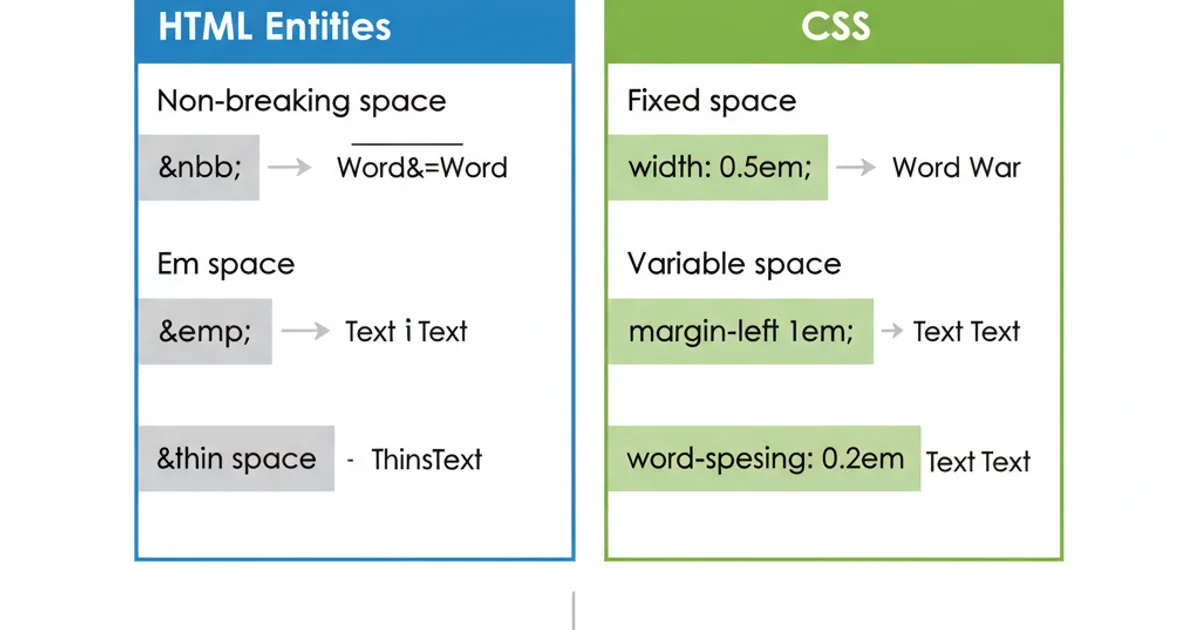Smaller space than
Categories:
Beyond : Exploring Smaller Whitespace Options in HTML

Discover various HTML entities and CSS properties to achieve precise, smaller whitespace than the non-breaking space ( ) for fine-tuning text layout and visual presentation.
In web development, controlling whitespace is crucial for aesthetic appeal and readability. While (non-breaking space) is a common go-to for preventing line breaks and adding a standard space, it often provides more space than desired for subtle adjustments. This article delves into alternative HTML entities and CSS techniques that offer finer control over whitespace, allowing you to achieve smaller, more precise spacing in your web content.
Understanding the Need for Finer Whitespace Control
The standard space character and are typically rendered with the same width as a normal word space, which can be quite large depending on the font and font size. For specific typographic scenarios, such as separating units from numbers (e.g., "10 kg" vs. "10kg"), aligning elements, or creating subtle visual gaps, a smaller space is often more appropriate. Over-reliance on can lead to awkward gaps or misaligned text, especially in responsive designs.
flowchart TD
A[Need for Whitespace] --> B{Standard Space / sufficient?}
B -- Yes --> C[Use Standard Space / ]
B -- No --> D[Need Smaller Space]
D --> E[HTML Entities (e.g.,  ,  )]
D --> F[CSS (e.g., margin, padding, letter-spacing)]
E --> G[Achieve Fine-Grained Control]
F --> GDecision flow for choosing whitespace methods
HTML Entities for Smaller Spaces
HTML provides several entities that represent different widths of space. These are particularly useful when you need a specific, fixed-width space that is smaller than a regular word space and want to avoid CSS for simple inline adjustments. They are also non-breaking by default, similar to .
<p>This is a normal space: <span>Hello World</span></p>
<p>This is a non-breaking space (&nbsp;): <span>Hello World</span></p>
<p>This is a thin space (&thinsp;): <span>Hello World</span></p>
<p>This is an en space (&ensp;): <span>Hello World</span></p>
<p>This is an em space (&emsp;): <span>Hello World</span></p>
Comparison of various HTML space entities
Let's break down the most common smaller space entities:
  is generally the smallest, its exact rendering can vary slightly across browsers and fonts. Always test your chosen entity in target environments.CSS for Dynamic and Flexible Whitespace
For more dynamic and flexible control over spacing, CSS is the preferred method. It allows you to define precise pixel, em, or rem based spacing, and apply it consistently across your design. This is especially powerful for responsive layouts where spacing might need to adapt.
<p>Using CSS `margin-right` for spacing: <span class="spaced-word">Hello</span><span>World</span></p>
<p>Using CSS `padding-right` for spacing: <span class="padded-word">Hello</span><span>World</span></p>
<p>Using CSS `letter-spacing` for tighter text: <span class="tight-text">HelloWorld</span></p>
<p>Using CSS `word-spacing` for custom word gaps: <span class="custom-word-spacing">Hello World</span></p>
HTML structure for CSS-controlled spacing
.spaced-word {
margin-right: 0.2em; /* Smaller than a typical word space */
}
.padded-word {
padding-right: 0.2em; /* Similar effect to margin-right */
}
.tight-text {
letter-spacing: -0.05em; /* Reduces space between letters */
}
.custom-word-spacing {
word-spacing: 0.5em; /* Adjusts space between words */
}
CSS rules for precise spacing control
CSS offers several properties that can be leveraged:
em or rem to ensure your spacing scales appropriately with font size and maintains responsiveness.When to Use Which Method
Choosing between HTML entities and CSS depends on the specific context and your design goals. Here's a general guideline:

HTML Entities vs. CSS for Whitespace Control
By understanding and utilizing these various methods, you can move beyond the limitations of and achieve a much higher degree of precision and control over the visual presentation of your text and elements on the web.